
USS St. George (CVE-17) was laid down on 31 July 1941 as a C3-S-A2 by Ingalls Shipbuilding, Hull 296 of Pascagoula, Mississippi, under Maritime Commission contract as the (second) SS Mormacland for Moore-McCormack Lines, Inc.,. She was renamed St. George (AVG-17) by the United States Navy on 7 January 1942; and assigned to the United Kingdom under Lend-Lease as HMS Pursuer on 24 February 1942. The vessel was launched on 18 July 1942, sponsored by Mrs. Mary Ann S. Bartman. The escort carrier was reclassified ACV-17 on 20 August 1942, acquired by the US Navy and simultaneously transferred to Britain on 14 June 1943. She was reclassified CVE-17 on 15 July 1943.

HMS Atheling (D51) was a Royal Navy Ruler-class escort carrier of the Second World War. She was a US built ship provided under lend lease and returned to the US at the end of hostilities.

USS Pybus (CVE-34) was initially a United States Navy Bogue-class escort carrier. The ship was transferred to the United Kingdom for service in the Royal Navy as the Ruler-class escort carrier HMS Emperor (D98) as part of the Lend-Lease program of World War II. Entering service in 1943, the ship took part in operations against the German battleship Tirpitz and the invasions of Normandy and southern France. Returned to the United States following the war, the carrier was sold for scrap in 1946.
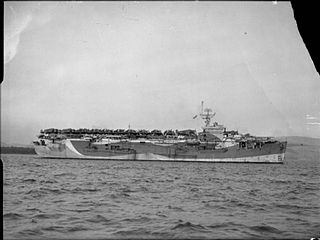
HMS Ameer (D01) was an American escort carrier, the USS Baffins (CVE-35), that was transferred to the Royal Navy in mid-1943. As a Ruler-class escort carrier served in the Far East until the end of the war. Ameer was returned to the US Navy in 1946 and sold off to commercial service.

USS Bolinas (CVE-36) was an escort carrier launched 11 November 1942 by Seattle-Tacoma Shipbuilding, Tacoma, Washington; sponsored by Mrs. G. B. Sherwood, wife of Commander Sherwood; and commissioned 22 July 1943, Captain H. L. Meadow in command.
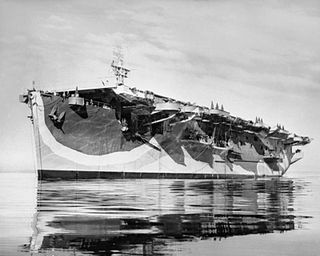
USS Bastian (CVE-37) was a Bogue-class escort aircraft carrier built by Seattle-Tacoma Shipbuilding of Tacoma, Washington, laid down on 25 August 1942 and launched 15 December 1942. She was transferred to the United Kingdom, under Lend-Lease and commissioned on 4 August 1943 as the Ruler-class escort carrier HMS Trumpeter (D09).

HMS Speaker (D90), a Ruler-class escort carrier, based on a "C3" hull, was originally the Bogue-classUSS Delgada (AVG/ACV/CVE-40), which was transferred to the United Kingdom under the Lend-Lease program.
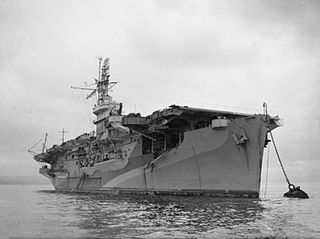
The first USS Estero (CVE-42) was an escort aircraft carrier launched 22 March 1943 by the Seattle-Tacoma Shipbuilding Corporation, Seattle, Washington, and sponsored by Mrs. C. N. Ingraham. She was reclassified CVE-42 on 15 July 1943. Completed in October 1943, she was transferred to the Royal Navy on 3 November 1943 and commissioned the same day as HMS Premier.

HMS Patroller was an escort carrier in the Royal Navy during the Second World War. Laid down in 1942 at the Seattle-Tacoma Shipbuilding company, she was originally named USS Keweenaw (CVE-44). USS Keweenaw was an escort carrier laid down under Maritime Commission contract by Seattle-Tacoma Shipbuilding of Tacoma, Washington, 27 November 1942; launched 6 May 1943; sponsored by Mrs. R. G. Risley; assigned to the United Kingdom 10 June 1943; reclassified CVE-44 on 15 July 1943; and transferred to the United Kingdom under lend-lease 22 October 1943.
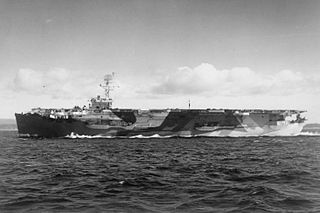
USS Prince (CVE-45) was an escort carrier laid down on 17 December 1942 by the Seattle-Tacoma Shipbuilding Corporation of Tacoma, Washington. She was renamed Prince on 13 November 1942 and launched on 18 May 1943. She was sponsored by Mrs. J. L. McGuigan, reclassified CVE-45 on 15 July 1943 and transferred to the United Kingdom under Lend-Lease on 17 October 1943.

USS Niantic (CVE-46) was a US escort carrier, that served in the Royal Navy as HMS Ranee (D03).

The USS Perdido (CVE-47) was a Bogue-class escort carrier laid down as ACV-47 under Maritime Commission contract by Seattle-Tacoma Shipbuilding of Tacoma, Washington, 1 February 1943; launched 16 June 1943; sponsored by Mrs. H. M. Bemis, reclassified as CVE-47 on 15 July 1943; and completed at the Commercial Iron Works, Portland, Oregon.

USS Sunset (CVE-48) was a Bogue-class escort carrier. Assigned on 23 August 1942 to MC hull 259, a modified C3-S-A1 laid down on 23 February 1943 by Seattle-Tacoma Shipbuilding of Tacoma, Washington; launched on 15 July and redesignated CVE-48 the same day; sponsored by Mrs. C.E. Taylor. She was transferred to the United Kingdom under Lend-Lease agreement on 19 November; and commissioned the same day as HMS Thane (D48), a Ruler-class escort carrier in the Royal Navy.

The USS St. Andrews (CVE-49) was assigned to MC hull 260 on 23 August 1942, a ship to be built to modified C3-S-A1 plans. She was laid down on 12 March 1943 by the Seattle-Tacoma Shipbuilding Corporation of Tacoma, Washington; redesignated CVE-49 on 15 July; and launched on 31 July; sponsored by Mrs. Robert W. Morse; transferred to the United Kingdom under Lend-Lease on 7 December; and commissioned the same day as HMS Queen (D19) in the Royal Navy.
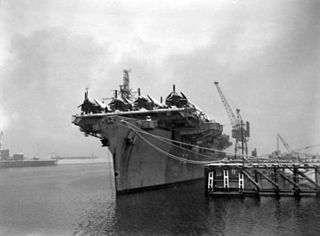
HMS Ruler was the lead ship of her class of escort carrier of the Royal Navy during the Second World War. She was built in the United States as the Bogue-class carrier St. Joseph (AVG/CVE/ACV-50) for Lend-Lease to the United Kingdom.

USS Vermillion (CVE-52) was laid down on 10 May 1943 by the Seattle-Tacoma Shipbuilding Corporation as a Bogue-class auxiliary aircraft carrier; redesignated an escort aircraft carrier, on 10 June 1943; assigned to the United Kingdom under Lend-Lease on 23 June 1943; launched on 27 September 1943; and accepted by Britain on 20 January 1944.

USS Winjah (CVE-54), was a Bogue-class escort carrier of the United States Navy, leased to the Royal Navy during World War II.

HMS Ravager (D70) was an Attacker-class escort carrier built in the United States and operated by the Royal Navy during World War II.
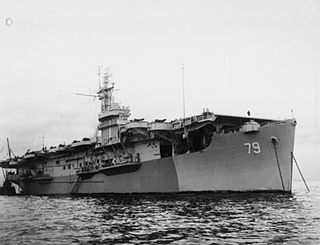
The Ruler-class of escort aircraft carriers served with the Royal Navy during the Second World War. All twenty-three ships were built by the Seattle-Tacoma Shipbuilding Corporation in the United States as Bogue-class escort carriers, supplied under Lend-Lease to the United Kingdom. They were the most numerous single class of aircraft carriers in service with the Royal Navy.

The Attacker class were a class of escort aircraft carriers in service with the British Royal Navy during the Second World War.




















